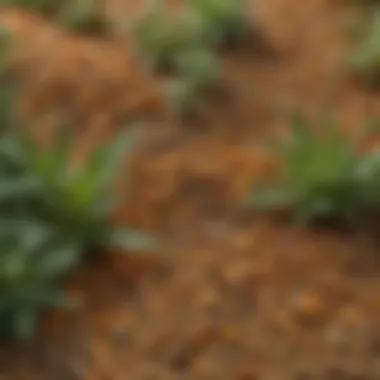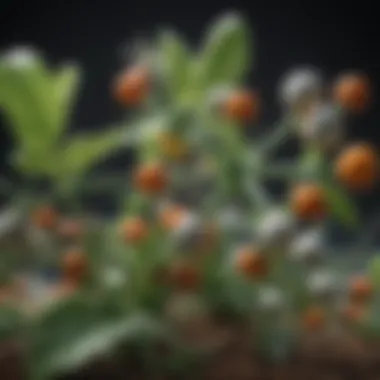Understanding the Ingredients of Preen Weed Preventer


Intro
Preen Weed Preventer is a widely used tool in the gardening community, known for its effectiveness in suppressing unwanted weeds. Understanding its ingredients is crucial for any farmer or gardening enthusiast aiming for successful management of invasive species. This section will explore key concepts related to Preen, its active ingredients, and how they function. By gaining knowledge about this product, users can make informed choices for their gardens as well as for the environment.
Key Concepts and Terminology
Definition of Terms
To fully grasp the subject, it's important to define some key terms:
- Weed Preventer: A substance that inhibits the growth of unwanted plants, often applied to soil prior to the germination of weeds.
- Active Ingredients: The chemical compounds in a product that contribute to its intended effects, such as controlling weeds.
- Pre-emergent Herbicide: A type of herbicide that targets weeds before they sprout, preventing their growth.
Overview of Relevant Practices
Using Preen Weed Preventer effectively requires an understanding of gardening practices. Regular application, according to the manufacturer's guidelines, can significantly reduce weed populations. A well-timed application, generally in early spring or late winter, is critical as it corresponds to the germination cycle of many weeds. Adopting integrated pest management practices that combine chemical and non-chemical methods can further enhance success in weed control.
Current Trends and Innovations
Latest Research and Developments
In recent years, studies have delved into the environmental impact of herbicides, including Preen. Research indicates a growing concern about runoff and its effects on native plant species. Innovations in formulation aim to reduce these impacts, providing safer alternatives without compromising effectiveness.
Emerging Technologies and Tools
Sustainable gardening practices are evolving with technology. Smart technologies, such as soil moisture sensors and drones, can help monitor plant health and target areas that require weed prevention without over-application of chemicals. Such advancements can enhance the effectiveness of Preen Weed Preventer as part of a broader gardening strategy.
Practical Applications
Step-by-Step Guides
- Preparation: Clear the area of existing weeds and debris before applying Preen.
- Application: Apply the product evenly across the soil surface. It’s crucial to follow the recommended dosage guidelines to avoid environmental damage.
- Watering: Water the area lightly. This helps activate the ingredients and ensures they penetrate the soil effectively.
- Monitoring: Observe the area for signs of effective weed suppression. Reapply as necessary, typically at intervals specified in the instructions.
Troubleshooting Common Issues
Even with careful application, some users may encounter problems. Here are common issues and solutions:
- Weed Resistance: Changing the type of weed preventer after a few cycles may help in preventing resistance development among weed populations.
- Surface Runoff: Ensure that the soil is sufficiently saturated to minimize the risk of runoff, especially before heavy rain.
"An informed approach to using Preen Weed Preventer can enhance both your garden and the surrounding ecosystem."
By understanding Preen's ingredients and their role in weed management, gardeners can make more effective choices. This knowledge base fuels the path toward sustainable gardening, blending efficiency with environmental stewardship.
Preface to Preen Weed Preventer
Weeds present a persistent challenge in gardening and agriculture. The introduction of Preen Weed Preventer marks a pivotal development in weed management strategies. Understanding the nuances of this tool is essential for anyone interested in maintaining a weed-free landscape efficiently.
Definition and Purpose
Preen Weed Preventer is a chemical formulation specifically designed to inhibit the germination of weed seeds. It achieves this by creating a barrier that prevents these seeds from establishing themselves in garden beds or landscaped areas. This product primarily targets annual weeds, which are problematic due to their rapid reproduction cycle. Control of these weeds is crucial, as they compete for nutrients, water, and light, often outpacing desirable plants.
In essence, Preen serves as a pre-emergent herbicide. Its function lies in its active ingredients, which interfere with the cellular processes that seedlings undergo when they attempt to sprout. The purpose of using Preen is not only to simplify weed management but also to reduce the need for potentially harmful post-emergent herbicides that can damage non-target plants.
The Role in Sustainable Gardening
In the context of sustainable gardening, Preen Weed Preventer plays a significant role. Utilizing it aligns with the principles of integrated pest management (IPM), which emphasizes long-term prevention of pests through a combination of techniques. By preventing weeds from growing in the first place, gardeners can minimize the need for more aggressive control methods later on.
Moreover, using a product like Preen can contribute to healthier ecosystems. Weeds often harbor pests and diseases; by suppressing their growth, gardeners not only protect their plants but also reduce the wider impact on the environment. In general, effective weed control leads to improved biodiversity, as healthier gardens can support a wider variety of plant and animal life.
Additionally, Preen's ease of use enhances its appeal. Gardeners can apply it as a simple preventive measure, making weed management less labor-intensive. This aligns with modern gardening trends that prioritize efficiency while maintaining ecological balance.
"Effective weed control is fundamental to the success of any garden. Preen provides a strategy to address weeds before they become an issue."


In summary, the importance of understanding Preen Weed Preventer lies in its dual function as a weed control solution and its contribution to sustainable gardening practices. Implementing its use can lead to healthier plants and a more aesthetically pleasing garden while minimizing environmental impact.
Key Ingredients in Preen Weed Preventer
Understanding the ingredients in Preen Weed Preventer is crucial for effective gardening. These components help manage weed growth effectively, giving plants the chance to thrive. Discussing the ingredients allows users to make informed decisions. Furthermore, knowledge of these elements enhances the overall gardening experience by promoting healthier landscapes.
Overview of Active Ingredients
Active ingredients are the core of any weed preventer. They work directly to inhibit weed growth, often interfering with specific processes in plants. Preen includes several active ingredients that each contribute uniquely to weed management. Understanding these components helps gardeners anticipate their effectiveness and any potential risks they may pose.
Herbicide Components
Herbicides play a key role in how Preen functions. These chemical agents selectively target weeds while aiming to minimize harm to desirable plants. Here are the notable herbicide components found in Preen:
Trifluralin
Trifluralin is a widely used herbicide with pre-emergent properties. It disrupts the normal growth patterns of weeds, essentially preventing germination. A key characteristic of Trifluralin is its long-lasting effect in the soil. This makes it a popular choice for gardeners seeking ongoing weed control. Additionally, its ability to control a variety of broadleaf and grassy weeds makes it versatile in various gardening contexts. However, it’s important to note that improper application can lead to adverse effects on nearby plants, which requires careful usage.
Pendimethalin
Pendimethalin also demonstrates pre-emergent capabilities. It operates similarly to Trifluralin but offers a different spectrum of weed control. A noteworthy feature of Pendimethalin is its effectiveness against annual grasses and some broadleaf weeds. It is often favored for its suitability in high-traffic areas due to its strong performance. Nevertheless, it can require specific conditions for optimal effectiveness, which may require adjustments in application techniques.
Benefin
Benefin is less common but serves an important role as well. It provides pre-emergent control, primarily for grass and broadleaf weeds. A distinctive attribute of Benefin is its fast action, often acting quickly within a short period after application. This quick effect is an advantageous quality for those needing immediate results. However, its efficacy can vary based on soil composition, making proper assessment crucial for successful weed prevention.
Role of Inert Ingredients
Inert ingredients are often overlooked but they serve important functions in the formulation of Preen. They help determine how the active ingredients are delivered, enhance stability, and assist in even application. While they may not actively combat weeds, their role in the overall efficacy of Preen is indispensable. Understanding their presence helps clarify how the entire product performs in a gardening context, ultimately supporting better results.
Mechanism of Action
Understanding how Preen Weed Preventer functions is crucial for any gardener or land manager aiming to maintain healthy landscapes. The mechanism behind its action determines its effectiveness in preventing weed growth while considering safety and environmental impacts. This section delves into the intricate processes by which Preen operates and emphasizes the need for proper application techniques.
How Preen Works
Preen Weed Preventer employs a combination of active ingredients to disrupt the life cycle of weeds. The primary ingredients prevent seed germination when applied to soil. For instance, Trifluralin, one of the active herbicides, creates a barrier that inhibits new weed seeds from sprouting. When Preen is applied correctly, it forms a protective layer on the soil surface. This barrier is essential for preventing various common weeds, including crabgrass and dandelions, keeping them at bay before they can establish themselves.
The effectiveness of Preen is reliant on proper timing and environmental conditions. It is most effective when applied just before weeds begin to germinate, correspondingly with the soil temperature and moisture levels. Garderners should be aware that the product does not kill existing weeds; it merely prevents new ones from sprouting. Applying Preen on a controlled basis, according to product guidelines, enhances its weed-preventing abilities.
Application Techniques
Applying Preen Weed Preventer entails specific techniques to optimize its performance. Here are several best practices for effective application:
- Soil Preparation: Before applying, ensure the soil is clean of established weeds. Raking or removing debris promotes successful results.
- Timing: The ideal time to apply Preen is early in the spring or fall, depending on the types of weeds prevalent in your area. Monitoring soil temperatures is crucial, since most weed seeds germinate at temperatures above 55°F.
- Method of Application: You may use a spreader for even distribution across the garden beds or flower beds. Ensure the product is evenly spread to prevent any patches where weeds might emerge.
- Watering: After application, lightly water the area. This helps activate the herbicides and ensures they penetrate the soil.
Effective usage of Preen requires a strategic approach, paying close attention to guidelines for optimal results.
In summary, understanding how Preen works and the correct application techniques is foundational to its successful use in weed prevention. Gardners can enjoy vibrant, weed-free gardens by following these practices, accommodating both environmental sustainability and plant health.
Safety Considerations
Understanding the safety considerations surrounding the use of Preen Weed Preventer is critical for responsible gardening and horticultural practices. Using any chemical solution requires careful thought and adherence to guidelines aimed at safeguarding both human health and the environment. By examining potential risks and necessary precautions, gardeners can make informed decisions regarding the application of Preen.
Human Health Risks and Guidelines
When utilizing Preen, it is essential to understand its components and how they can affect human health. The active ingredients, particularly in herbicides like Trifluralin and Pendimethalin, may pose risks if not handled properly. These substances can be harmful if ingested or inhaled, thus ensuring that protective measures are in place is vital.
To minimize health risks:
- Wear Protective Gear: Always don gloves, masks, and goggles while applying Preen. This protects the skin, respiratory system, and eyes from potential irritation.
- Read Labels Thoroughly: Labels contain specific instructions on application, storage, and first aid measures. Following these guidelines helps avoid accidents.
- Keep Away from Food: Ensure that the area where Preen is applied is not close to edible plants. This prevents contamination.
- Wash Hands: After handling, always wash your hands thoroughly, even if gloves were used, to avoid incidental exposure.


Following these guidelines contributes to safe gardening practices, ensuring that the use of Preen remains beneficial rather than hazardous to health.
Environmental Impact Assessment
Evaluating the environmental impact of Preen Weed Preventer is just as crucial as human health considerations. The ingredients in Preen can affect soil health, water quality, and non-target species. Understanding these impacts aids in making responsible choices.
Key factors to consider include:
- Soil Composition: Regular use of synthetic herbicides may alter the soil microbiome, affecting plant health over time.
- Water Runoff: During heavy rains, chemicals can leach into local waterways, potentially harming aquatic life and impacting water quality.
- Biodiversity: Herbicides can affect beneficial insects, birds, and other wildlife. Striking a balance between weed control and wildlife conservation is essential.
"The application of herbicides should always consider the broader ecological context to avoid unintended consequences."
Addressing these environmental concerns involves careful monitoring of application practices, along with assessing long-term impacts. Awareness of potential effects leads to more sustainable use of Preen and better outcomes for garden ecosystems.
Comparative Analysis
Comparative analysis serves as a vital element in understanding how Preen Weed Preventer stands against other weed management solutions. It provides insight into different types of ingredients, effectiveness, and overall value. Evaluating various options not only aids in making informed decisions but also identifies potential strengths and weaknesses associated with Preen and its competitors. The insights gained from this analysis can enhance your approach to weed management in diverse gardening scenarios.
Preen vs. Other Weed Preventers
Chemical Comparisons
When discussing chemical comparisons among weed preventers, one must focus on the specific active constituents that define their functions. Preen contains herbicides like Trifluralin and Pendimethalin which directly inhibit weed growth through root interference. In contrast, other products may use different types of chemical formulations such as glyphosate, which target the entire plant.
A key characteristic of chemical comparisons lies in the distinct modes of action each herbicide employs. Preen's ingredients create a barrier in the soil, preventing weed seeds from germinating while causing less disruption to existing plants. This makes Preen a favorable choice for gardeners looking for targeted weed control.
However, there are downsides. Some might argue that relying on chemical solutions runs the risk of developing herbicide-resistant plants over time, making effective control more complicated. This unique feature of chemical comparisons highlights diverse pathways to achieve weed management.
Effectiveness in Various Conditions
Effectiveness in various conditions plays a significant role in weed prevention. Variability in climate, soil type, and existing weed species makes it crucial to choose a product that performs well across those diverse scenarios. Preen, often praised for its ability to function effectively in a range of environments, proves particularly valuable. For example, it maintains strong weed suppression even in less-than-ideal soil conditions.
A notable characteristic of effectiveness is its adaptability. Preen's formulation allows for greater flexibility, making it suitable for both dry and wet climates. It can be applied before or after precipitation, ensuring that gardeners can use it at their convenience. However, conditions such as heavy rain within a short time post-application may reduce its overall effectiveness by washing away the product.
This feature makes effectiveness in various conditions significant, as it emphasizes the necessity for gardeners to understand climatical influences on herbicide performance.
Cost-Effectiveness Considerations
Cost-effectiveness is an essential topic within the analysis of Preen and its competitors. Understanding the financial implications of choosing one weed preventer over another can inform better gardening decisions. Preen is typically viewed as a mid-range product in terms of price, offering good performance for its cost. While there are cheaper options, they may not provide equal efficiency in controlling weeds.
Thus, considering the long-term savings from fewer applications can sometimes justify the initial expense. In contrast, high-cost products often boast unique features, but their necessity is dependent on specific gardening needs. This evaluation helps in understanding the balance between cost and value in weed management strategies.
Best Practices for Use
Using Preen Weed Preventer effectively requires understanding best practices that optimize its benefits while minimizing possible drawbacks. Knowing timing, frequency, and application methods enhances the efficacy of this product. It ensures that the weeds are effectively controlled and the health of desirable plants is maintained. Such knowledge is crucial for those who wish to achieve a well-managed garden or landscape.
Timing and Frequency of Application
Timing is essential when using Preen Weed Preventer. Applying it at the right moment can significantly impact weed control. Generally, the best period to apply is before weeds begin to germinate. This timing usually corresponds with seasonal changes when soil temperatures rise sufficiently. Therefore, late spring or early fall are often recommended. Weeds thrive under specific conditions, and catching them early is vital to effective prevention.
Moreover, the frequency of application is equally important. Following the manufacturer's guidelines is key. For most formulations, a single application can last about three months if maintained under ideal conditions. A second application can be performed if weeds begin to appear, but one should avoid over-applying. Excessive use can disrupt soil health and potentially harm desirable plants. Understanding the local climate and soil conditions can aid in determining the most effective intervals for reapplication.
Recommended Application Methods
The methods of application also play a crucial role in achieving maximum effectiveness from Preen. Here are some recommended techniques to consider:
- Dry Application: Spread the granules evenly over the soil surface. This method helps in creating a protective barrier against new weed seeds. Make sure to water lightly after application to help activate the ingredients without causing runoff.
- Liquid Application: Some formulations are made for spray application. For this approach, ensure the correct dilution ratios as indicated on the label. Use a sprayer to apply an even coat on the targeted areas. This method can penetrate deeper into the soil compared to dry application.
- Avoid Disturbance: After applying Preen, avoid disturbing the soil. Tilling or excessive raking can disrupt the barrier and reduce effectiveness.
It is also beneficial to keep an eye on weather conditions. Avoid applying before heavy rains, which can wash away the product and reduce its efficacy. Likewise, following local regulations about herbicide use can help maintain compliance and contribute to effective gardening.
Applying Preen at precise moments and using correct methods are fundamental to weed management. Proper practices lead to healthier plants and greater garden success.


Alternatives to Preen Weed Preventer
The quest for effective weed management is crucial for gardeners and landscape enthusiasts. While Preen Weed Preventer offers a reliable solution, alternative methods should not be overlooked. Exploring these options can provide different perspectives on weed management. Moreover, understanding these alternatives can lead to more sustainable gardening practices. This section emphasizes the significance of evaluating organic and cultural practices within the context of weed control, ensuring that gardeners have a diverse toolkit for maintaining healthy landscapes.
Organic Weed Management Options
Organic methods of weed control focus on maintaining soil health and promoting beneficial plants. Two notable strategies are mulching and the use of natural herbicides. These approaches not only target weeds but also support overall ecosystem balance.
Mulching Techniques
Mulching involves covering the soil with organic or inorganic materials. This technique is a protective measure against weed growth. The key characteristic of mulching is its ability to suppress weeds by blocking sunlight, thus hindering their growth. It is popular because it enhances soil moisture retention and improves aesthetic appeal. There are many materials for mulching:
- Straw
- Wood chips
- Bark
- Grass clippings
The unique feature of mulching is its dual function. It prevents weeds while also enriching the soil as organic materials decompose. However, one must consider that not all mulch types are equal. For instance, wood chips break down slowly, lasting longer compared to straw, which decomposes quickly.
Advantages of mulching include:
- Reduced need for herbicides
- Improved soil healthy
- Enhanced garden appearance
Disadvantages could be:
- Initial costs for materials
- Potential for pests if not managed properly
Natural Herbicides
Natural herbicides offer a more environmentally friendly method for weed control. They utilize plant-based ingredients that target unwanted plants without harsh chemicals. The main characteristic here is their non-toxic nature, appealing to those concerned with chemical use in gardening. Popular natural herbicides include:
- Vinegar
- Salt
- Boiling water
A unique feature of these products is their accessibility. Gardeners can often easily source and prepare these substances at home, making them a cost-effective solution. However, natural herbicides may require multiple applications for effectiveness. They can also harm desirable plants if not applied carefully.
Advantages include:
- Eco-friendliness
- Cost savings
Disadvantages involve:
- Limited effectiveness on perennial weeds
- Risk of damaging desirable plants
Cultural Practices for Weed Control
Cultural practices refer to gardening techniques aimed at preventing weed growth through better management. This involves a holistic approach, emphasizing the importance of healthy plants and soil management. These practices can include crop rotation, proper spacing of plants, and maintaining soil health.
"Healthy soil leads to healthier plants, which are more capable of competing with weeds."
Effective cultural practices foster a thriving garden environment. For example, rotating crops reduces nutrient depletion and disrupts weed life cycles. Adjusting plant spacing can also create competition among plants, filling gaps that allow weeds to thrive. With the integration of these cultural methods, gardeners can achieve sustainable weed management while cultivating productive landscapes.
Culmination
The conclusion of this article serves as a critical reflection on the comprehensive insights provided regarding Preen Weed Preventer. Understanding the ingredients, their functionalities, and safety considerations is essential for those who engage in gardening or landscape management. Integrating such knowledge can lead to better decision-making when selecting weed management strategies, particularly as many face the challenges of invasive plant species.
A few specific elements stand out in this discussion. First, the key ingredients in Preen are important not only for their effectiveness but also for their safety profile. Recognizing how these ingredients interact with the environment enhances the ability to implement them responsibly. Moreover, understanding the cost-effectiveness of using Preen in different conditions is vital for gardeners planning their budgets and approaches over the growing season.
Additionally, as alternative weed management techniques gain traction, it is critical to remain open to innovations and changes in strategy. Today's gardeners are often in search of sustainable practices that not only address weed issues but also align with broader environmental goals.
As we conclude, let us emphasize the ongoing need to adapt and refine our methods for weed prevention. The exploration of both conventional and organic options reflects a diverse toolkit available for various gardening situations.
Summary of Key Points
- Preen Weed Preventer's ingredients have specific functions that contribute to its effectiveness in weed control.
- Active ingredients, like trifluralin, play a significant role in preventing weed seeds from germinating.
- Understanding the environmental impacts and safety guidelines are essential for effective usage.
- There are various cost-effective alternatives to Preen that gardeners can explore.
- Sustainable gardening increasingly includes a range of methods to manage weeds effectively.
Future of Weed Prevention Strategies
Looking ahead, the future of weed prevention strategies is poised for transformation. With ongoing research, there is potential for new herbicides and non-chemical management techniques to emerge. Innovations in biotechnology are likely to offer targeted solutions that minimize collateral damage to desirable plants.
Moreover, societal trends toward organic gardening could drive a shift in how products like Preen are viewed in the market. Consumers increasingly seek products that align with ecological principles, which could lead to more organic alternatives gaining acceptance. Also, community engagement and education will be pivotal in promoting awareness about integrated weed management practices.
As more people become familiar with the benefits of combining chemical and non-chemical strategies, this holistic approach could redefine weed management paradigms. Understanding the psychological factors influencing gardening choices will also shape future strategies. A balance between effective weed control and environmental stewardship will likely continue to be a focal point in horticultural advancements.







